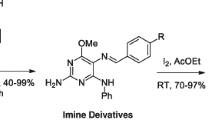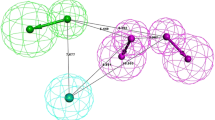Abstract
The present study is an attempt in this direction seeking for the development and comparison of QSAR models of substituted 2-aminopyridine derivatives as inhibitors of nitric oxide synthases by different feature selection methods. The QSAR study was carried out on V-life Molecular Design Suite software, and the derived best QSAR model was derived by partial component regression method. The statistically significant best model with high correlation coefficient (\(r^{2}=0.8408\)) was selected for further study. The model was further validated by means of crossed squared correlation coefficient (\(q^{2}=0.7270\) and \(\hbox {pred}\_r^{2}=0.7889\)) which shows model has good predictive ability. The best 3D-QSAR model showed \(q^{2}=0.8377,\,r^{2} = 0.8739\) and standard error = 0.1954. The predictive ability of the resultant model was evaluated using a test set molecules and the predicted \(r^{2}=0.8159.\) The results reveal that the acceptor, donor, aliphatic, and aromatic pharmacophore properties are favorable contour sites for both the activities. The two-dimensional and k-nearest-neighbor contour plots were required for further understanding of the relationship between structural features of substituted 2-aminopyridine derivatives and their activities which should be applicable to design newer potential inducible nitric oxide synthases.


Similar content being viewed by others
References
Kerwin JF, Lancaster JR, Feldman PF (1995) Nitric oxide: a new paradigm for second messengers. J Med Chem 38:4343–4362
Moncada S, Palmer RM, Higgs EA (1991) Nitric oxide: physiology, pathophysiology, and pharmacology. Pharmacol Rev 43:109–142
Griffith OW, Stuehr DJ (1995) Nitric oxide synthases: properties and catalytic mechanism. Annu Rev Physiol 57:707–736
Masters BSS, McMillan K, Sheta EA, Nishimura JS, Roman LJ, Martasek P (1996) Neuronal nitric oxide synthase, a modular enzyme formed by convergent evolution: structure studies of a cysteine thiolate-liganded heme protein that hydroxylates l-arginine to produce NO as a cellular signal. FASEB J 10:552–558
Marletta MA (1994) Nitric oxide synthase: aspects concerning structure and catalysis. Cell 78:927–930
Alderton WK, Cooper CE, Knowles RG (2001) Nitric oxide synthases: structure, function and inhibition. Biochem J 357:593–615
Huang H, Younghee L, Zhang HQ, Fast W, Riley B, Silverman RB (2001) In: Campbell MM, Blagborough IS (eds) Medicinal chemistry into the millennium. Royal Society of Chemistry, Cambridge, p 325
Pfeiffer S, Mayer B, Hemmens B (1999) Nitric oxide: chemical puzzles posed by a biological messenger. Angew Chem Int Ed Engl 38:1714–1731
Stuehr DJ (1999) Mammalian nitric oxide synthases. Biochim Biophys Acta 1411:217–230
Li H, Poulos TL (2005) Structure-function studies on nitric oxide synthases. J Inorg Biochem 99:293–305
Davis KL, Martin E, Turko IV, Murad F (2001) Novel effects of nitric oxide. Annu Rev Pharmacol Toxicol 41:203–236
Leone AM, Palmer RM, Knowles RG, Francis PL, Ashton DS, Moncada S (1991) Constitutive and inducible nitric oxide synthases incorporate molecular oxygen into both nitric oxide and citrulline. J Biol Chem 266:23790–23795
Nathan C, Xie QW (1994) Nitric oxide synthases: roles, tolls, and controls. Cell 78:915–918
Stuehr DJ, Kwon NS, Nathan CF, Griffith OW, Feldman PL, Wiseman J (1991) N omega-hydroxy-l-arginine is an intermediate in the biosynthesis of nitric oxide from l-arginine. J Biol Chem 266:6259–6263
Forstermann U, Pollock JS, Schmidt HH, Heller M, Murad F (1991) Calmodulin-dependent endothelium-derived relaxing factor/nitric oxide synthase activity is present in the particulate and cytosolic fractions of bovine aortic endothelial cells. Proc Natl Acad Sci USA 88:1788–1792
MacMicking J, Xie QW, Nathan C (1997) Nitric oxide and macrophage function. Annu Rev Immunol 15:323–350
Suckling CJ, Gibson CL, Huggan JK, Morthala RR, Clarke B, Kununthur S, Wadsworth RM, Daffc S, Papale D (2008) 6-Acetyl-7,7-dimethyl-5,6,7,8-tetrahydropterin is an activator of nitric oxide synthases. Bioorg Med Chem Lett 18:1563–1566
Sorlie M, Gorren ACF, Marchal S, Shimizu T, Lange R, Andersson KK, Mayer BJ (2003) Single-turnover of nitric-oxide synthase in the presence of 4-amino-tetrahydrobiopterin: proposed role for tetrahydrobiopterin as a proton donor. J Biol Chem 278:48602–48610
Wei C-C, Crane BR, Stuehr D (2003) Tetrahydrobiopterin radical enzymology. Chem Rev 103:2365–83
Szabo C, Lim LHK, Cuzzocrea S, Getting SJ, Zingarelli B, Flower RJ, Salzman AL, Perretti M (1997) Inhibition of poly (ADP-ribose) synthetase attenuates neutrophil recruitment and exerts antiinflammatory effects. J Exp Med 186:1041–1049
Dinerman JL, Lowenstein CJ, Snyder SH (1993) Molecular mechanisms of nitric oxide regulation. Potential relevance to cardiovascular disease. Circ Res 73:217–222
Murad F (1999) Cellular signaling with nitric oxide and cyclic GMP. Braz J Med Biol Res 32:1317–1327
Schmidt HH, Walter U (1994) NO at work. Cell 78:919–925
Liberatore GT, Jackson-Lewis V, Vukosavic S, Mandir AS, Vila M, McAuliffe WG, Dawson VL, Dawson TM, Przedborski S (1999) Inducible nitric oxide synthase stimulates dopaminergic neurodegeneration in the MPTP model of Parkinson disease. Nat Med 5:1403–1409
Bingham CO III (2002) The pathogenesis of rheumatoid arthritis: pivotal cytokines involved in bone degradation and inflammation. J Rheumatol 65:3–9
Kankuri E, Vaali K, Knowles RG, Lahde M, Korpela R, Vapaatalo H, Moilanen E (2001) Suppression of acute experimental colitis by a highly selective inducible nitric-oxide synthase inhibitor, N-[3-(aminomethyl)benzyl]acetamidine. J Pharmacol Exp Ther 298:1128–1132
Taddei S, Virdis A, Ghiadoni L, Sudano I, Salvetti A (2001) Endothelial dysfunction in hypertension. J Cardiovasc Pharmacol 38(2):S11–14
Rekka EA, Chrysselis NC (2002) Nitric oxide in atherosclerosis. Mini Rev Med Chem 2:433–445
Moncada S, Higgs EA (1995) Molecular mechanism and therapeutic strategies related to nitric oxide. FASEB J 9:1319–1330
Olken NM, Marletta MA (1993) N \(^{G}\)-methyl-l-arginine functions as an alternative substrate and mechanism-based inhibitor of nitric oxide synthase. Biochemistry 32:9677–9685
Benigni R, Bossa C (2008) Predictivity of QSAR. J Chem Inf Model 48:971–980
Tropsha A (2003) History of quantitative structure activity relationships. In: Abraham DJ (ed) Burger’s medicinal chemistry and drug discovery. Wiley, Hoboken
Chaudhary NA, Kumar A, Juyal V, Tiwari M (2008) QSAR analysis of substituted amino pyridines as inducible nitric oxide synthase inhibitors. Ind Drug 45(5):247–255
Hagmann WK, Caldwell CG, Chen P, Durette PL, Esser CK, Lanza TJ, Kopka IE, Guthikonda R, Shah SK, MacCoss M, Chabin RM, Fletcher D, Grant SK, Green BG, Humes JL, Kelly TM, Luell S, Meurer R, Moore V, Pacholok SG, Pavia T, Williams HR, Wong KK (2000) Substituted 2-aminopyridines as inhibitors of nitric oxide synthases. Bioorg Med Chem Lett 10:1975–1978
Vlife MDS software package (2008) version 3.5, supplied by Vlife science technologies Pvt. Ltd, Pune
Halgren TA (1996) Merck molecular force field. III. Molecular geometries and vibrational frequencies for MMFF94. J Comput Chem 17:553–586
Metropolis N, Rosenbluth AW, Rosenbluth MN, Teller AH (1953) Equation of state calculations by fast computing machines. J Chem Phys 21:1087–1092
Baumann K (2002) An alignment-independent versatile structure descriptor for QSAR and QSPR based on the distribution of molecular features. J Chem Inf Comput Sci 42:26–35
Golbraikh A, Tropsha A (2002) Predictive QSAR modeling based on diversity sampling of experimental datasets for the training and test set selection. J Comput Aided Mol Des 16:357–369
Ajmani S, Jadhav K, Kulkarni SA (2006) Three-dimensional QSAR using the k-nearest neighbor method and its interpretation. J Chem Inf Model 46:24–31
Clark M, Cramer RD III, Van ON (1989) Validation of the general purpose tripos 5.2 force field. J Comput Chem 10:982–1012
Gasteiger J, Marsili M (1980) Iterative partial equalization of orbital electronegativity—a rapid access to atomic charges. Tetrahedron 36:3219–3228
Cramer RD, Patterson DE, Bunce JD (1988) Comparative molecular field analysis (CoMFA). 1. Effect of shape on binding of steroids to carrier proteins. J Am Chem Soc 110:5959–5967
Leach AR, Gillet VJ (2003) An introduction to chemoinformatics. Kluwer, Boston
Guyon I, Elisseeff A (2003) An introduction to variable and feature selection. J Mach Learn Res 3:1157–1182
Darlington RB (1990) Regression and linear models. McGraw-Hill, New York
Zheng W, Tropsha A (2000) Novel variable selection quantitative structure-property relationship approach based on the k-nearest neighbor principle. J Chem Inf Comput Sci 40:185–194
Kirkpatrick S, Gelatt CDJ, Vecchi MP (1983) Optimization by simulated annealing. Science 220:671–680
Bagchi MC, Ghosh P (2009) QSAR modeling for quinoxaline derivatives using genetic algorithm and simulated annealing based feature selection. Curr Med Chem 16:4032–4048
Acknowledgments
The author thanks Vlife Science Technologies Pvt. Ltd., for providing the software for the study.
Author information
Authors and Affiliations
Corresponding author
Rights and permissions
About this article
Cite this article
Sharma, M.C. Comparative Pharmacophore Modeling and QSAR Studies for Structural Requirements of some Substituted 2-Aminopyridine Derivatives as Inhibitors of Nitric Oxide Synthases. Interdiscip Sci Comput Life Sci 7, 100–112 (2015). https://doi.org/10.1007/s12539-015-0004-3
Received:
Revised:
Accepted:
Published:
Issue Date:
DOI: https://doi.org/10.1007/s12539-015-0004-3




